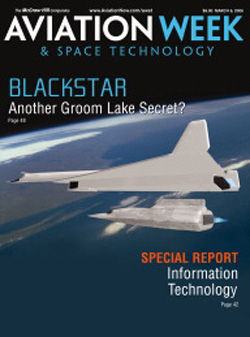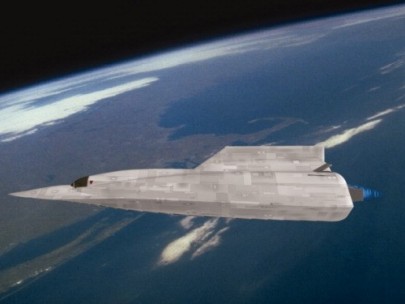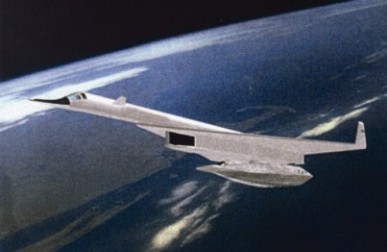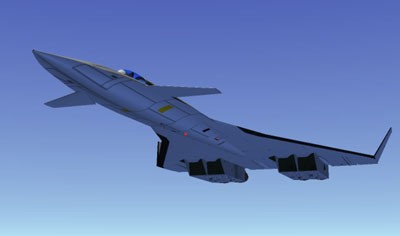|
Blackstar Spaceplane |
|||
Two-Stage-to-Orbit ''Blackstar''
System Shelved at Groom Lake?
"Artist's concept depicts an XB-70-like carrier aircraft dropping a manned spaceplane at high altitude. Possibly developed in the late-1980s, the highly classified two-stage-to-orbit " Blackstar" system could place a small payload in low Earth orbit or serve as a rapid-response reconnaissance platform. The two vehicles were seen several times throughout the 1990s, but may have been shelved in recent years, according to officials familiar with the program. Graphic by James Petty and Travis Thatcher." |
|||
|
Blackstar is the reported codename of a secret United
States orbital spaceplane system. The possible existence of the Blackstar
program was reported in March 2006 by Aviation Week & Space Technology
(Aviation Week, AWST) magazine; the magazine reported that the program
had been underway since at least the early 1990s, and that the impetus
for Blackstar was to allow the United States Government to retain orbital
reconnaissance capabilities jeopardised following the 1986 Challenger disaster.
The article also said that the United States Air Force's Space Command
was unaware of Blackstar, suggesting it was operated by an intelligence
agency such as the National Reconnaissance Office.[1][2]
Aviation Week speculated that such a spacecraft could also have offensive military capabilities (a concept colloquially known as "The Space Bomber" [3][4]). The magazine also stated that it was likely that Blackstar would be mothballed, although it is unclear whether this is due to cost or failure of the program. The Aviation Week report was a few days later dismissed as "almost certainly bogus" and the project termed a "technical absurdity" by Jeffrey F. Bell in an article in Spacedaily. SOURCE: Wikipedia |
|||
|
..
Technology By wiredog (Tue Mar 07, 2006 at 08:43:01 AM EST) Intel,
Deep Black, Intelligence, SpacePlane (all tags). This is interesting. Back when my Dad worked for DMA
(later NIMA, now NGA) he subscribed to Aviation Week. It was referred to
by insiders (like Dad) as "Aviation Leak" because it tended to find out
things that insiders (like Dad) would rather it didn't.
Things like the SR-3/XOV Blackstar, which replaced the SR-71. |
|||
| Excerpt:
On Oct. 4, 1998, the carrier aircraft was spotted flying over Salt Lake City at about 2:35 p.m. local time. James Petty, the president of JP Rocket Engine Co., saw a small, highly swept-winged vehicle nestled under the belly of the XB-70-like aircraft. The vehicle appeared to be climbing slowly on a west-southwest heading. The sky was clear enough to see both vehicles' leading edges, which Petty described as a dark gray or black color. For whatever reason, top military space commanders apparently have never been "briefed-in"--never told of the Blackstar system's existence--even though these are the "warfighters" who might need to employ a spaceplane in combat. Consequently, the most likely user is an intelligence agency. The National Reconnaissance Office may have played a role in the program, but former senior NRO officials have denied any knowledge of it. One Pentagon official suggests that the Blackstar system was "owned" and operated by a team of aerospace contractors, ensuring government leaders' plausible deniability. When asked about the system, they could honestly say, "we don't have anything like that." SOURCE: Aviation Week (Archived) At the time, an industry official said, "if we're flying a spaceplane, it makes sense to kill these cover programs and stop wasting money on things we can already do." |
|||
|
"Boeing is believed to be
one of several major aerospace companies involved in the Blackstar program.
On Oct. 14, 1986, Boeing filed a U.S. patent application for an advanced
two-stage space transportation system. Patent No. 4,802,639, awarded on
Feb. 7, 1989, details how a small orbiter could be air-dropped from the
belly of a large delta-winged carrier at Mach 3.3 and 103,800-ft. altitude."
- Aviation
Week
Horizontal-takeoff transatmospheric launch system Publication number: US4802639
Abstract of US4802639 This invention is directed toward providing a transatmospheric launch system that is essentially totally reusable, provides wide flexibility in choice of orbit, and may be launched quickly on short notice. The system of the invention is a two-stage horizontal takeoff and landing system. An orbiter vehicle (50) is integrated into the underside of an aircraft (2). Aircraft (2) has a cavity (4) opening aftwardly and downwardly to receive vehicle (50). Vehicle (50) and aircraft (2) are releasably connected by struts (30, 32). Aircraft (2) and vehicle (50) proceed to staging conditions under air breathing and then rocket power. Rocket engine (22) of aircraft (2) is throttled to produce a thrust differential with rocket engine (66) of vehicle (50). This differential causes vehicle (50) to automatically pivot away from aircraft (2) on struts (30, 32). After pivoting out of cavity (4), vehicle (50) is disengaged from struts (30, 32) and proceeds on its own to orbit. Aircraft (2) makes a conventional landing. Following reentry, vehicle (50) makes an unpowered horizontal landing. Separation is accomplished at a Mach number of about 3.3. In a second embodiment, the main engine of the orbiter (50') is a scramjet (101) instead of a rocket. "Whether the Blackstar system was ever declared operational or not is unknown, but several orbiters may have flown over the years. A former program manager at a major aerospace company once declared, "There's no question; Lockheed is flying a two-stage space vehicle." - Aviation Week |
|||
Blackstar – fact or fiction? Blackstar SR-3 and the XOV
In March 2006 Aviation Week & Space Technology
(AW&ST) carried a report by William B Scott about the retirement of
a top-secret re-usable spaceplane named ‘Blackstar’, that was widely reported
in various aviation magazines and websites. The report described how in
the 1980’s, under a highly classified ‘black’ programme, the US had developed
a ‘two-stage-to-orbit’ system that could place a small military spaceplane
in low-earth orbit. The system was reported as comprising a large ‘carrier’
aircraft, modelled on the XB-70 Valkyrie supersonic bomber, known as the
SR-3 and a small, highly swept-wing, two-man spaceplane known as the XOV.
The SR-3, supposedly carrying the XOV conformally underneath its fuselage,
could take-off conventionally and was capable of accelerating to something
around Mach 3 at around 100,000ft, and then it would release the spaceplane
that would fire its own rocket engine and rise up into low-earth orbit.
The SR-3 would return to base and land conventionally and, after completing
its mission, the XOV would re-enter the atmosphere and return to earth
much like the space shuttle, gliding down for a conventional landing. It
was reported that the ‘Blackstar’ system enabled the US to conduct surprise
reconnaissance of foreign military activities that were usually hidden
from regularly scheduled reconnaissance-satellite overflights and could
also be used for satellite insertion and possibly even weapons delivery.
The XOV was apparently moved around in one of two specially modified C-5C
Galaxy aircraft.
Unfortunately, AW&ST in general and William B Scott in particular, have a long track record of bogus articles in which a previously unheard of ‘black’ programme is revealed for the first time in an exclusive article. This trend started way back in 1957 when AW&ST revealed the existence of a Soviet nuclear powered bomber with the ability to remain airborne for days at a time and almost unlimited range. The truth that eventually emerged was that the actual aircraft itself, the Myashischev M-59, was entirely conventional and possessed such poor performance that it never went into full scale production. Then in the 1990s Scott wrote a number of articles in AW&ST about top-secret aircraft that had been developed under ‘black’ programmes. These included articles about a hypersonic bomber capable of carrying nuclear warheads in vertical ejection racks, the triangular TR-3 Manta that supported F-117 Nighthawk operations and of course the enigmatic Aurora hypersonic spyplane. The only consistent factor over all the years these articles have appeared is that not one genuine photograph of the aircraft has ever appeared and not one of these aircraft has been de-classified and revealed. Consequently, many observers have come to regard many of these AW&ST articles as a mixture of government or corporate disinformation or just flights of fancy designed to boost the magazines circulation. Nevertheless, there have also been occasions when an article in AW&ST has revealed for the first time a previously classified programme, such as the Have Blue programme that eventually lead to the F-117 stealth fighter, the Northrop Tacit Blue programme and Boeing’s Bird of Prey proof of concept vehicle – so sometimes they do also tell the truth. Since the Blackstar article appeared in AW&ST, a whole series of articles written by informed and knowledgeable individuals have appeared on various Internet sites that examine the details William B Scott provides and without exception come to the same conclusion – the report is almost certainly bogus. So without prejudice to what’s already been written, in this article I’ll review some of the claims and draw my own conclusions. Over the past a number of years various separate reports were made by a variety of people that had sighted a large, delta-winged aircraft, similar in size and appearance to the cancelled XB-70 Valkyrie bomber, in the south-west of the USA. Some reports even came up with a name for this particular aircraft – Brilliant Buzzard or Blue Eyes, although it has never been determined exactly where these names came from or whether someone simply made them up to add an air of authenticity to the sightings. However, what is beyond dispute is that although the XB-70 was cancelled back in the mid-1960s, the technology behind the programme had by that stage been effectively proved and the aircraft had demonstrated the ability to cruise at Mach 3 at around 70,000ft. There were certainly some flaws in the original design, particularly with the hydraulic systems and wing hinges, but this was nothing unusual for such a highly advanced design and there’s little doubt that these problems could have easily been overcome with sufficient investment and testing. North American XB-70 Valkyrie 62-207 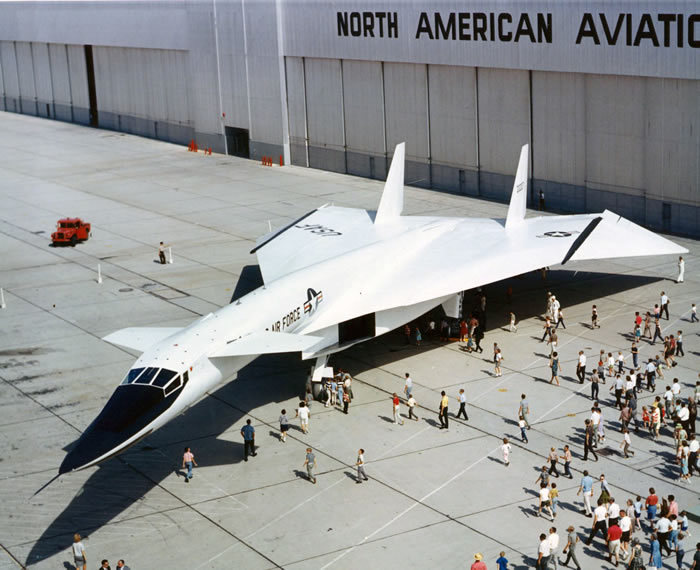
In the event, only two XB-70s were ever built, 62-001 & 62-207, and the first is in the USAF Museum and the second and most advanced aircraft was destroyed in a mid-air collision. Construction had actually started on a third XB-70 prototype that would have been much closer to the final production design when the prototype test programme was cancelled in 1964. To keep the B-70 program alive, proposals were made to equip this third aircraft with even more extensive research capabilities than the earlier prototypes had received. These included plans to use the aircraft as a high-altitude astronomical observatory, a recoverable first stage booster for launching payloads into orbit, a platform for launching anti-satellite weapons, a high-altitude communications relay, a high-speed propulsion test craft, and a vehicle to test methods of reducing radar cross section. Although construction of this aircraft was well underway, it was cancelled prior to completion – so what happened to it and had other components already been ordered for follow-on aircraft? In reality I suspect that the partially completed XB-70 was actually broken up for scrap, furthermore, as the production programme was cancelled in 1961, and future plans had never really progressed that much beyond the prototype stage, I think it highly unlikely that North American would have committed itself to the huge risk of ordering additional components in the hope of possibly securing a future order – it just doesn’t make commercial sense. 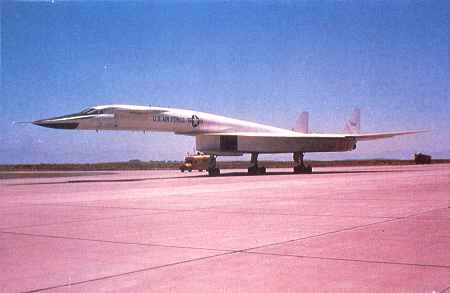 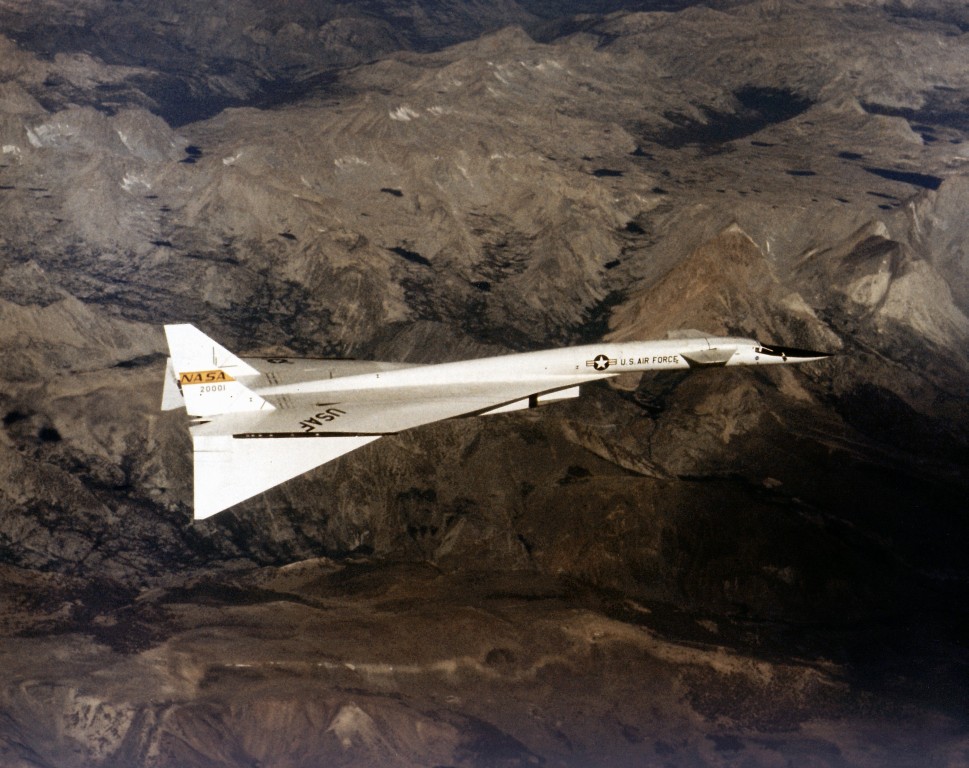 A NASA XB-70 in 1968. White delta-wing aircraft overflying mountains. The front of the fuselage features canard wings, and the wing tips are dropped. Boeing's mothership/spaceplane patent I also believe that there is very little likelihood of a major US defence contractor deciding to use 1960’s technology in a highly advanced Mach 3 aircraft in the 1990’s – it just doesn’t make sense. Aviation technology has made such huge advances over the intervening 30 years, particularly in avionics and engine design, that these would be simply negated by operating such an old design as the XB-70, unless it was completely rebuilt, in which case it would be easier to simply start again from scratch. Furthermore, you couldn't carry anything sizable resessed underneath the XB-70 centreline - that's where the engines are located. Nevertheless, the basic XB-70 design had been proven by the test programme, particularly the use of compression lift created by trapping the airflow below the fuselage by lowering the wing tips. . Therefore, if during the 1980’s a US contractor was awarded a contract under a ‘black’ programme to investigate the possibility of developing mothership/spaceplane combination, the basic XB-70 design would almost certainly have been the obvious starting point. With this in mind, perhaps there is some significance in Boeing filing patent design 4.802.639 in Oct 1986 for a spaceplane/mothership combination, even if it only bears a passing resemblance to the XB-70? Blackstar carrying the XOV If an updated version of the XB-70, called the SR-3, or something similar was actually built, would it have been designed to carry spaceplane underneath the fuselage? This is where I begin to have some difficulties with the Blackstar concept as it has been reported. If an SR-3 of the size necessary to carry an XOV below the fuselage exists it would have to be equipped a long and heavy undercarriage and this would have to be positioned near the centre of gravity, in exactly the same area of fuselage that the XOV would also have to be located. I think that if an SR-3 design was based on the XB-70 design it would also use compression lift and have wingtips that could be lowered to create this effect. A modern fly-by-wire system would negate the need for a tail, particularly if the wingtips could also be raised at slower speeds. This would then allow an XOV to be carried on top of the fuselage and, with the wingtips lowered at Mach 3, the top of the fuselage would be clear of anything to obstruct its release The XOV However, unless the US has made a remarkable breakthrough
in engine and fuel technology, or the XOV actually carries a couple of
expendable rockets, the main reason why the whole Blackstar article appears
bogus is basic orbital physics. Every study to date has determined that
a launch at Mach 3 and 100,000ft just won’t reduce the ~90% fuel fraction
needed for a ground launched SSTO system by enough for it to achieve Mach
25 and 300nm low earth orbit. Even if the Blackstar system existed, I can’t
really see why it would be used to launch a small satellite, particularly
when commercial systems such as the Pegasus and Minotaur are readily available.
The US has already deployed and operated at least two small stealth satellites
that can manoeuvre in orbit and hide themselves alongside orbiting ‘space
junk’ as well as deploying countermeasures to prevent detection by optical
or radar tracking systems. These satellites, known as 'Misty', have almost
certainly overflown areas of interest undetected in advance by the country
targeted and allowing them no time to hide activities of interest. For
this reason I cannot see much advantage in a Blackstar system for ‘surprise’
overflights of denied areas. Unless the US have developed a very effective
system for masking the hot exhaust plumes of the XOV, early warning satellites
would easily pick up the XOV as it climbed into low earth orbit, allow
its orbital parameters to be predicted, and give sufficient time for sensitive
items to be hidden or deception measures to be put into place.
The article in AW&ST also mentions the existence of two specially modified C-5 Galaxy transport aircraft that were used to ferry the XOV around. Unfortunately the serial numbers quoted do not exist and as all the C-5 Galaxy produced can be accounted for, there is little doubt that the author is simply in error. Two Galaxy aircraft, 68-0213 and 68-0216, were specially modified into C-5C Space Cargo Modified (SCM) aircraft which enabled them to carry various outsize payloads and satellites in a large Space Container Transportation System (STCS) that could just be squeezed inside the modified fuselage, so Bill Scott appears to have confused the well-known activities undertaken by these aircraft, with ‘black’ activity in support of his Blackstar system. In summary, like many others, I simply do not believe the broad detail of the AW&ST article. Nevertheless, what is beyond dispute is that between 1990 – 1992 a series of sonic booms were tracked across Southern California by independant observers, usually in the early hours of the morning, heading in the direction of Nevada where Area 51 is located. The sonic booms were calculated to have been produced by an aircraft flying above Mach 3 and higher than 100,000ft. It was later proved beyond doubt that neither the Space Shuttle or any SR-71’s were airborne at the time – so some unidentified, unknown, very fast, high flying aircraft was certainly out there 15 years ago and if so why were the sonic booms not heard after 1992? Why did the aircraft that was producing these sonic booms suddenly disappear? The one thing all observers of US black programmes seem to agree on is that the US has developed and operated a whole series of very high performance aircraft over the last 30 years that have yet to be revealed; however, I also believe that currently there is insufficient evidence to support the existence of a Blackstar system, as described in the AW&ST article. Hopefully, the truth will eventually emerge but, if the system did exist, it’s existence will only be confirmed when the technology behind it has been superseded by something even more advanced. In the meantime, I think I’ll settle on giving the reported Blackstar system a verdict used under the Scottish legal system – ‘not proven’. SOURCE: Spyflight
UK
"Interestingly, after both
Lockheed and Boeing pulled out of the NASP competition (or were "eliminated")
in the 1980s, they may have collaborated to develop the two-stage-to-orbit
Blackstar system under a highly classified "fast-track" program. However,
many other contractors' "deep-black" teams probably also were involved
in order to bring the nation's best expertise to bear on what must have
been daunting technical challenges."
|
|||
| Related Links: |
|||
| FAIR USE NOTICE: This page contains copyrighted material the use of which has not been specifically authorized by the copyright owner. Pegasus Research Consortium distributes this material without profit to those who have expressed a prior interest in receiving the included information for research and educational purposes. We believe this constitutes a fair use of any such copyrighted material as provided for in 17 U.S.C § 107. If you wish to use copyrighted material from this site for purposes of your own that go beyond fair use, you must obtain permission from the copyright owner. | |||
|
|
